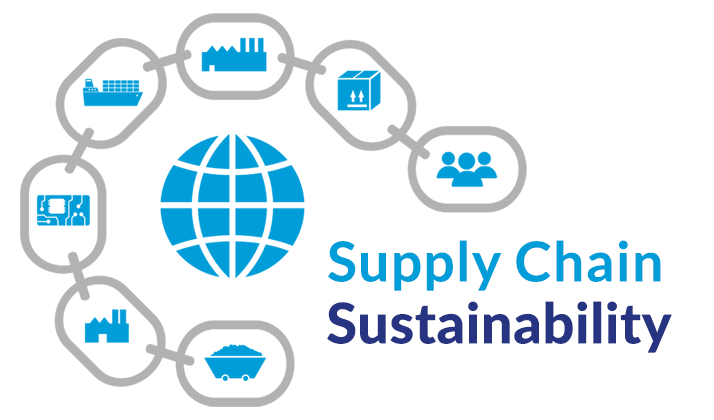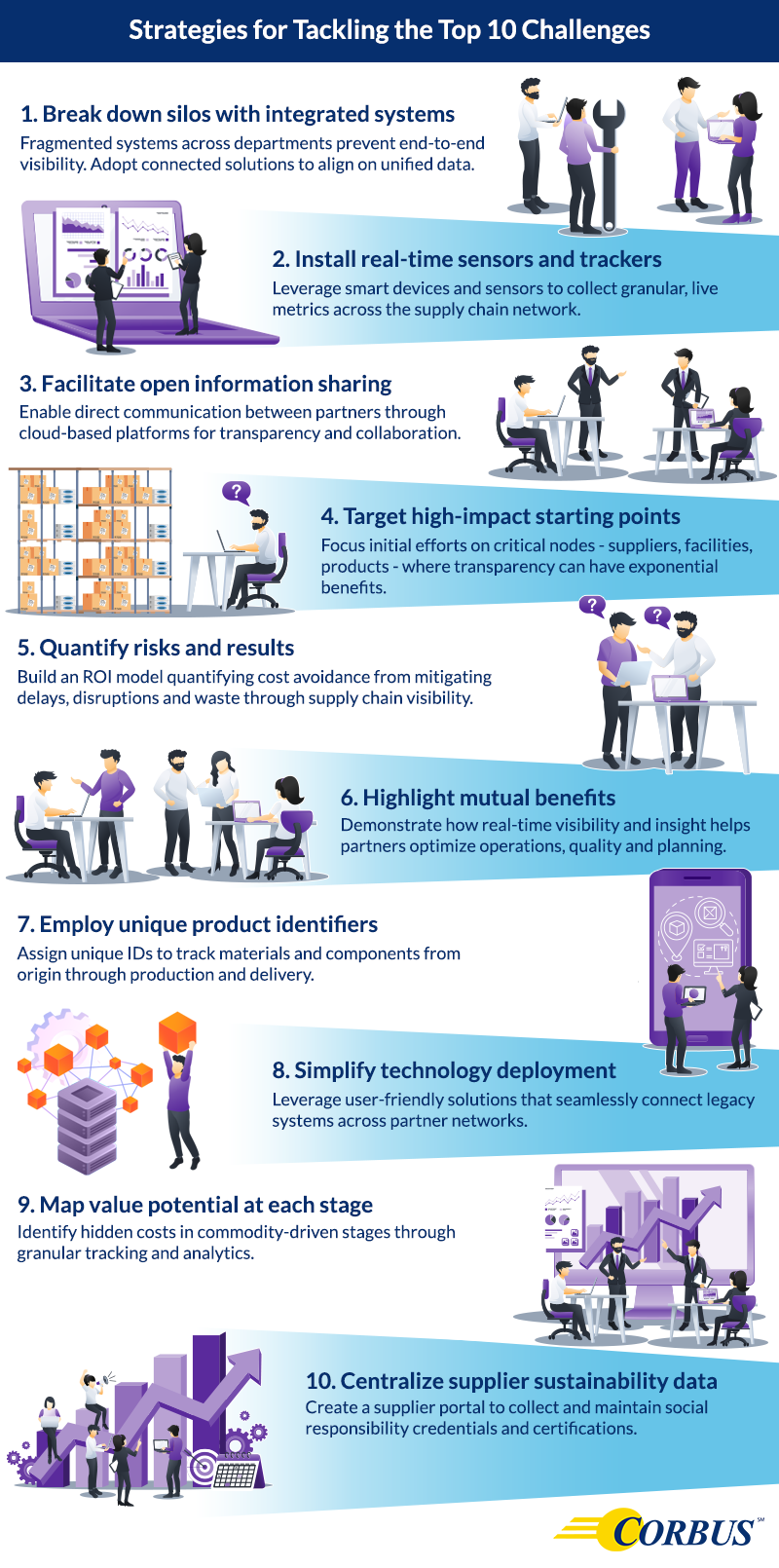Conquering the Top 10 Challenges of Implementing Supply Chain Transparency

Sustainability in your supply chain is non-negotiable. What is standing in your way?
“A lack of supply chain transparency can now stop businesses cold.” That’s what Alexis Bateman said in the 2019 Harvard Business Review article What Supply Chain Transparency Really Means. At Corbus, we believe that not focusing on sustainability and the environment can harm a business. Customers demand responsible sourcing, ethical business practices and environmental stewardship in finished products. At the same time, regulators expect the metrics to prove it. However, unlocking full supply chain visibility is difficult without expertise. So, what prevents companies from implementing complete transparency to further their sustainability strategies? Quite simply: Most supply chains were not designed to be transparent.
Overcoming the top 10 challenges to achieving global supply chain transparency
For more than 25 years, we have been experts in supply chain consulting and procurement, assisting companies with their supply chain operations. During this time, we have gained valuable insights, and here we share the top 10 challenges organizations encounter when trying to establish an ethical and transparent supply network, and strategies for mitigating these challenges.
We want you to benefit from the lessons we have learned, enabling you to create a more sustainable and transparent supply chain for your organization. This information is an excerpt from our new whitepaper, Enhancing Sustainability Through Supply Chain Transparency.
1. Break down silos with integrated systems
Fragmented systems across departments prevent end-to-end visibility. This makes managing product data, inventory, transportation, quality control and other functions more difficult. Adopt connected solutions to align on unified data. This, along with change-management strategies can help to break down silos.
2. Install real-time sensors and trackers
It can be difficult to see the whole supply chain because there isn’t always real-time data available. This data includes production amounts, parts sourcing, lead time, inventory levels, shipment locations and other specific metrics. These factors are spread throughout a complex supply chain. By leveraging smart devices and sensors to collect granular, live metrics across the supply chain network, organizations access real-time relevant data.
3. Facilitate open information sharing
Supply chain partners ranging from component suppliers to logistics providers often have inadequate communication channels, limiting openness and collaboration. Enable direct communication between partners through cloud-based platforms for transparency and collaboration. Additionally, forming cross-functional teams can foster idea exchange.
4. Target high impact starting points
Identifying the optimal starting point can be daunting given the vast scale and complexity of global supply chains. First efforts should be in high-risk, high-value areas. Focus initial efforts on critical nodes: suppliers, facilities, products—where transparency can have exponential benefits. Corbus has experts who can provide a fresh outlook on your situation. We can assist you by efficiently navigating transformation.
5. Quantify risks and results
Securing executive commitment and resources to fund long-term supply chain transformation requires a compelling business case. The case should show benefits such as risk reduction, sustainability and cost savings. Build an ROI model quantifying cost avoidance from mitigating delays, disruptions and waste through supply chain visibility. We house research, precedent-setting case studies and a broad information base to help gain approval throughout the organization.
6. Highlight mutual benefits
Suppliers and others may not want to share information or use new technology without rewards and proof of benefits. Demonstrate how real-time visibility and insight helps partners optimize operations, quality and planning. Clear policies and change management can facilitate this engagement.
7. Employ unique product identifiers
Tracking complex products with many parts is difficult because you must trace each material back to its source. Assign unique IDs to track materials and components from origin through production and delivery. Understand that your organization may need to phase transparency by product line.
8. Simplify technology deployment
Using advanced technology like blockchain in supply chains can be difficult due to real-world challenges in technology and user-friendliness. Leverage user-friendly solutions that seamlessly connect legacy systems across partner networks. Our solution experts bring an innovative approach to solving these issues at sustainability touchpoints.
9. Map value potential at each stage
When purchasing basic materials and parts, transparency efforts may not appear valuable at first glance. However, these efforts can bring benefits. Identifying hidden costs in commodity-driven stages through granular tracking and analytics facilitates value mapping at each stage, uncovering potential for improvement. Even lower tier suppliers who are sourcing raw materials can greatly impact your environmental stewardship metrics.
10. Centralize supplier sustainability data
Many organizations struggle to compile data on supply chain partners, especially in lower tiers. Companies often only have access to scattered and unorganized information. Create a supplier portal to collect and maintain social responsibility credentials and certifications. Our sustainability team partners with Corbus IT solution experts to create custom dashboards that provide instant visibility into metrics like supply chain disruption. This allows for supply chain resilience.
Your proven partner for supply chain integrity and visibility
The 2023 Sustainable Business Survey found that managing supply chains is the biggest challenge for companies focusing on sustainability. Global supply chains are complicated and struggle to be transparent because of internal and external factors. This is not surprising.
We believe sustainability and transparency are non-negotiable as any organization pursues growth, resilience and heightened trust in a hyper-dynamic marketplace.
Our job is to remove obstacles and pave a path to transparency. We help clients ensure their worldwide operations meet standards for product quality, ethical sourcing, labor rights and environmental impact. We also perform audits and use track-and-trace systems to keep standards high.
We encourage you to read the entire white paper, Enhancing Sustainability Through Supply Chain Transparency where Boris Christow, Business Solution Architect/Sustainability, talks more thoroughly about the challenges and benefits of transparency.
The white paper outlines best practices for launching successful sustainability transparency initiatives.
- The context and importance of transparent sustainability
- The benefits of transparency
- Common challenges and how to overcome them
- The Corbus guide to achieving transparency in your business
- The performance gains of supply chain transparency
Access the entire white paper here.
To learn more about how Corbus can transform your business and build momentum for the future, contact us. We are here to help.